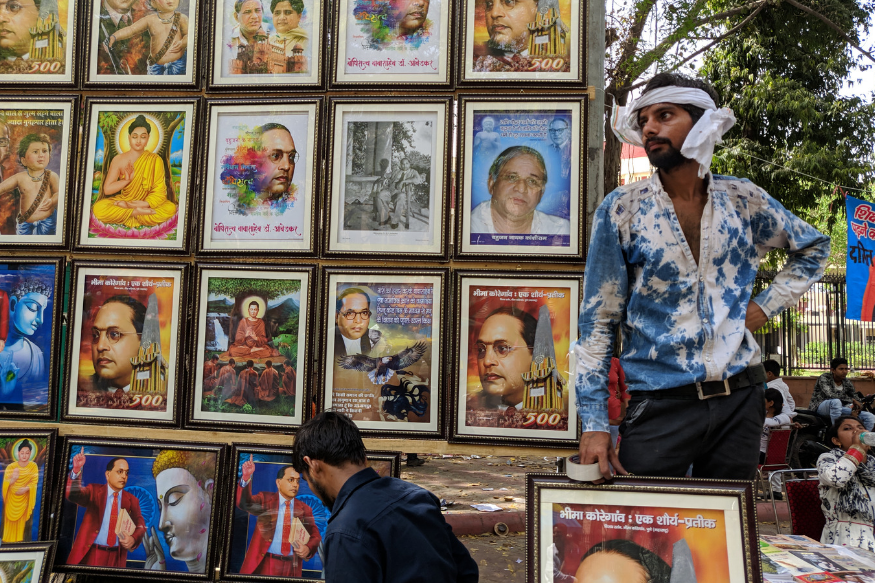
New Delhi: The BJP’s atrocities have awakened the Dalits, says 28-year-old Arjun Singh. According to him, the last five years have worked in the favour of his community. “Dalits are more united today, more politically aware and assertive because of the injustices under BJP’s rule,” he says.
Singh, a resident of Hapur in Uttar Pradesh, has been coming to the Parliament Street in New Delhi on Ambedkar Jayanti for five years now. On April 14, the birth anniversary of B.R. Ambedkar, and the only day when the Parliament opens its gates to the public, thousands of Dalits, young and old, throng the Sansad Marg.
The premises are dotted with serpentine queues of people, who eagerly wait for their turn to pay respects to the iconic Amedkar statue located inside Parliament. This year, the longstanding tradition gains special significance in the backdrop of the Lok Sabha elections, which are currently underway.
On Sunday, the 128th birth anniversary of Ambedkar, Singh stood in line for an hour in Parliament, but came out beaming. So did 42-year-old Sanjay Kumar, who has been making the ritual visit to the statue for 15 years. “This is the biggest turnout I have ever seen. Maybe because it’s a Sunday, maybe because it’s elections. But out community is also more aware now,” Kumar says.
As thousands congregate at the Sansad Marg, the Jantar Mantar and all the way to Parliament building, the mood is palpably political, with elections steering conversations on all sides.
Amid the dozens of stalls on either side of the iconic street, there are many which assert the political will of the Dalit community. One such pop-up is by Chandrashekhar Azad Ravan’s Bhim Army, a party representing the Dom community. Even Bahujan Samaj Party (BSP) merchandise is on the cards, with several stalls devoted to the sale of products flashing BSP pride.
The dominant dress code is blue, spotted and sported in the flowing fabric of sarees, the sinewy folds of t-shirts and stiff collared shirts. The air crackles with slogans like ‘Jai Bhim’ as the sea of blue sweeps over the street, chanting in unison.
This march to Parliament is symbolic. It is where the community wants representation. Pankaj Raj, 28, an engineer employed at a private firm, believes Dalit mobilisation must lead to unified political assertion. “There is a huge crowd here today. I want it to convert into votes, into representation,” he says.
Raj recognises the importance of 2019 elections not just for his community, but for all the people his age. “The biggest issue in the last five years is the rising unemployment. Government jobs are going empty. There is no hiring for permanent vacancies,” he says.
“The youth doesn’t want a temple or a mosque. They want jobs,” he adds.
30-year-old Ajay Kumar, who has come all the way from Varanasi, Prime Minister Narendra Modi’s constituency, says the current government has systematically worked against Dalit upliftment. “Last five years have been the worst for us,” he says, “They tried to impose the 13-point roster (for reservation in teaching jobs in higher education), they brought in 10 percent reservation for the General community, they fuelled atrocities against us in Una, Bhima Koregaon, Muzaffarnagar.”
According to him, the mass of people gathered at Sansad Marg is proof of rising Dalit assertion. “More leaders from our community are emerging in the political fray, Chandrashekhar Azad, Jignesh Mevani. It makes me happy to see this,” he says.
Singh, however, is concerned about how the rise of Dalit political expression is amiss in the dominant public discourse of media. “Wherever you see on television, it’s only Modi. How many rallies of Mayawati ji are covered? Look at today. Lakhs from our community are standing in front of the parliament. Do you see any news channel cameras?” he says, echoing the larger sentiment of discontent brewing within the community.
Even when Dalits are represented in the media, they are used as tokens, says Eklavya Ambedkar, who runs a Dalit publication in Lucknow. “When elections come you see Modi washing our feets on television. But his government is working to break our legs,” he says.
According to Singh, the unification of Dalit sentiment started in April last year, when the community protested against changes in the SC and ST Prevention of Atrocities Act. The Bharat Band, that saw lakhs of Dalits take to the streets, created a feeling of unity, Singh says. “Our people came of the roads and fought back. They now know that BJP is the enemy.”
25-year-old Aman, resident of Mayur Vihar, says that he wasn’t very involved in community movements earlier. But April 2 changed that. “That year I came to Parliament Street on 14 April for the first time. This is the second time I’m here and I’m getting goose bumps all over again,” Aman says, who is accompanied by his family this time.
For Singh, the battle is bigger than this, one that fights not just for Dalit rights, but also to safeguard India’s constitution. “Baba sahib drafted our constitution that provided equal rights and opportunities to all. BJP is trying to burn the constitution. And if they come back to power, they will succeed,” he says.